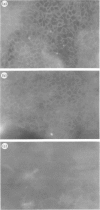Abstract
During the induction phase of skin sensitization, dendritic cells (DC), many of which bear high levels of antigen, accumulate in lymph nodes draining the site of exposure. These DC derive from epidermal Langerhans' cells (LC) which are induced to migrate from the skin, via the afferent lymphatics, to lymph nodes. We demonstrated previously that intradermal exposure of mice to homologous, but not human, recombinant tumour necrosis factor-alpha (TNF-alpha) also causes an accumulation of DC in draining nodes, the implication being that the local production of this cytokine by epidermal cells provides one stimulus for LC migration. In the present study we have examined the influence of dermal TNF-alpha on the frequency of LC within the epidermis. Intradermal injection of mice with 25 ng or greater murine recombinant TNF-alpha caused a significant reduction in LC numbers within 30 min of exposure. The same treatment did not influence the frequency of Thy-1+ epidermal DC. The density of LC was unaffected by the same amount of human TNF-alpha of comparable specific activity or by murine granulocyte-macrophage colony-stimulating factor (GM-CSF). These data provide additional evidence that TNF-alpha provides an important signal for the migration of LC from the epidermis.
Full text
PDF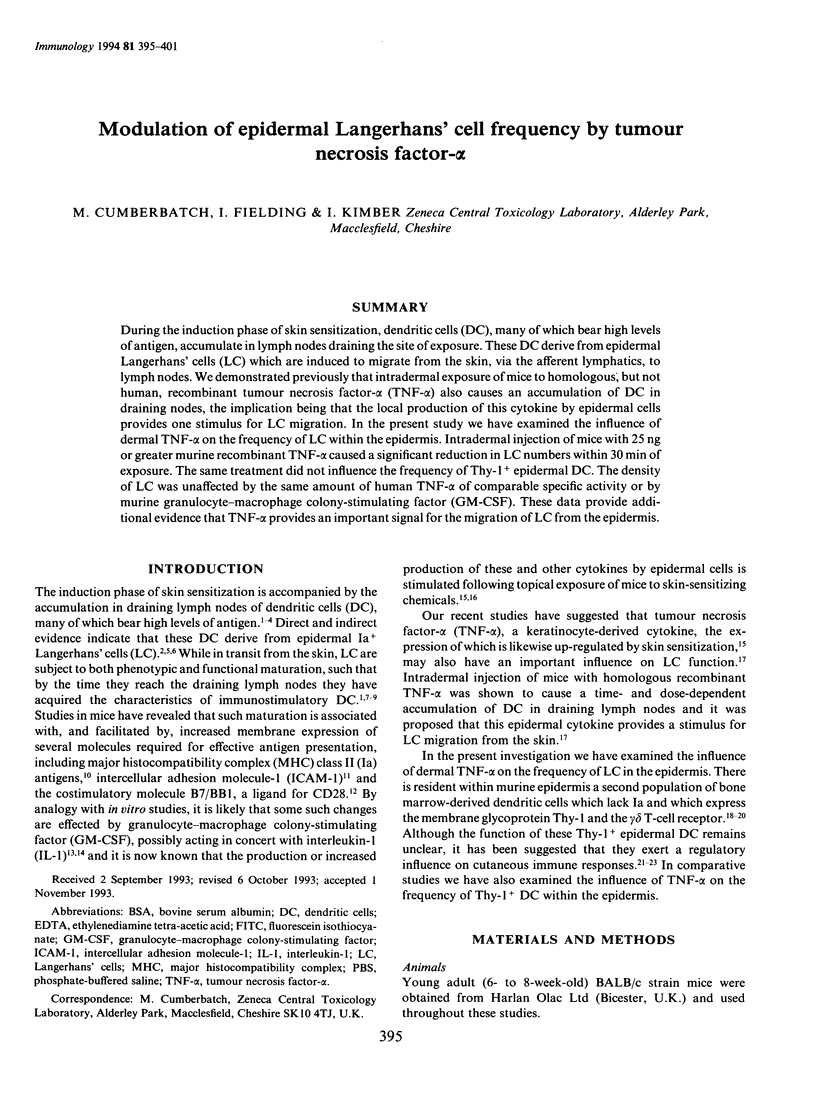
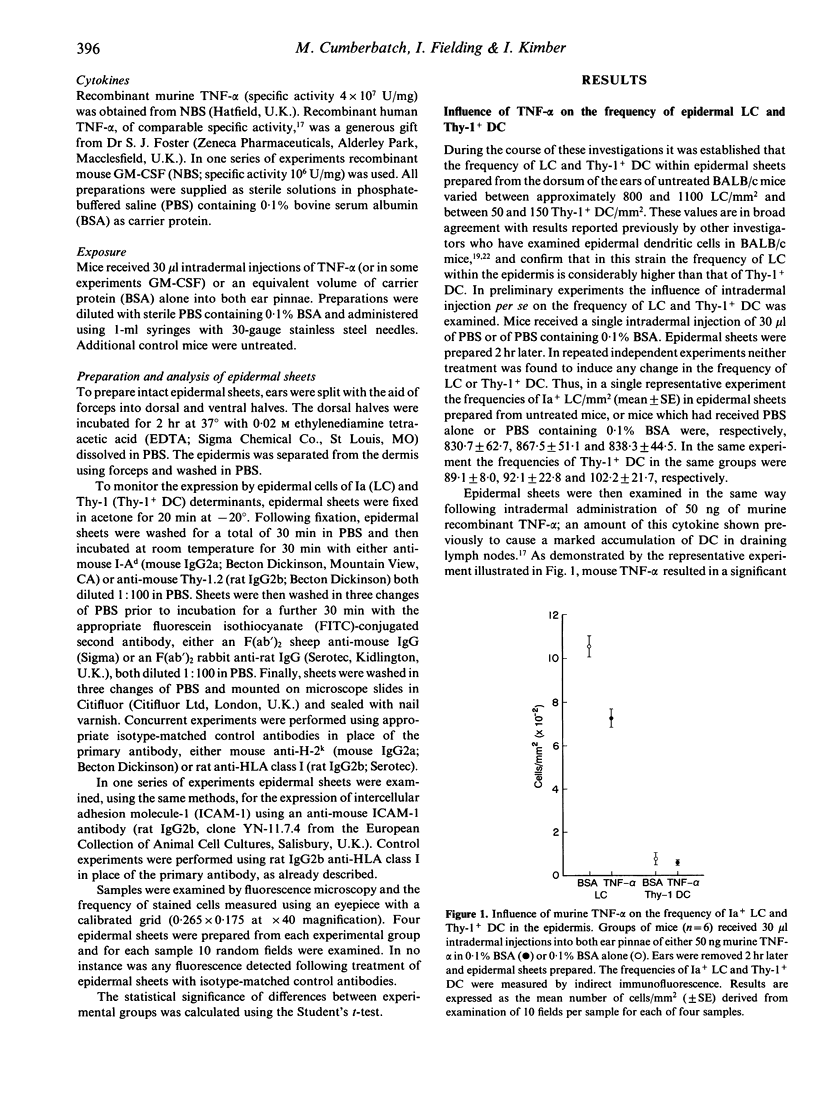
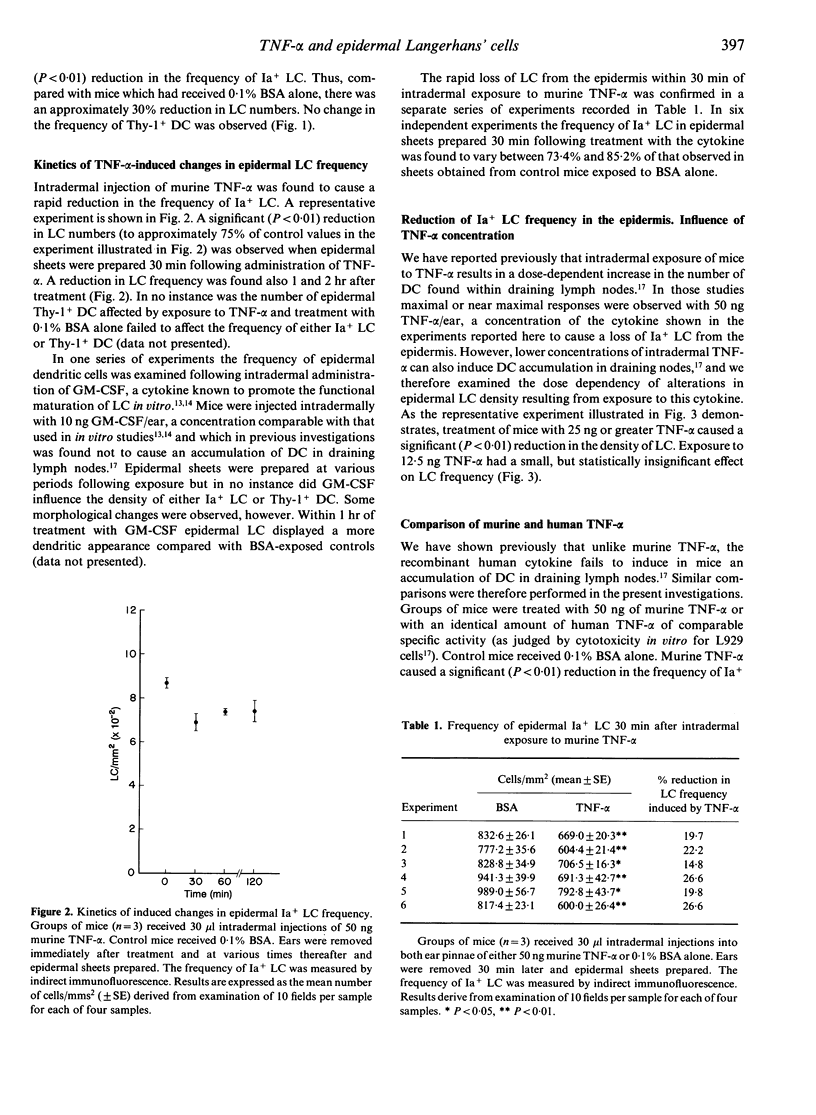
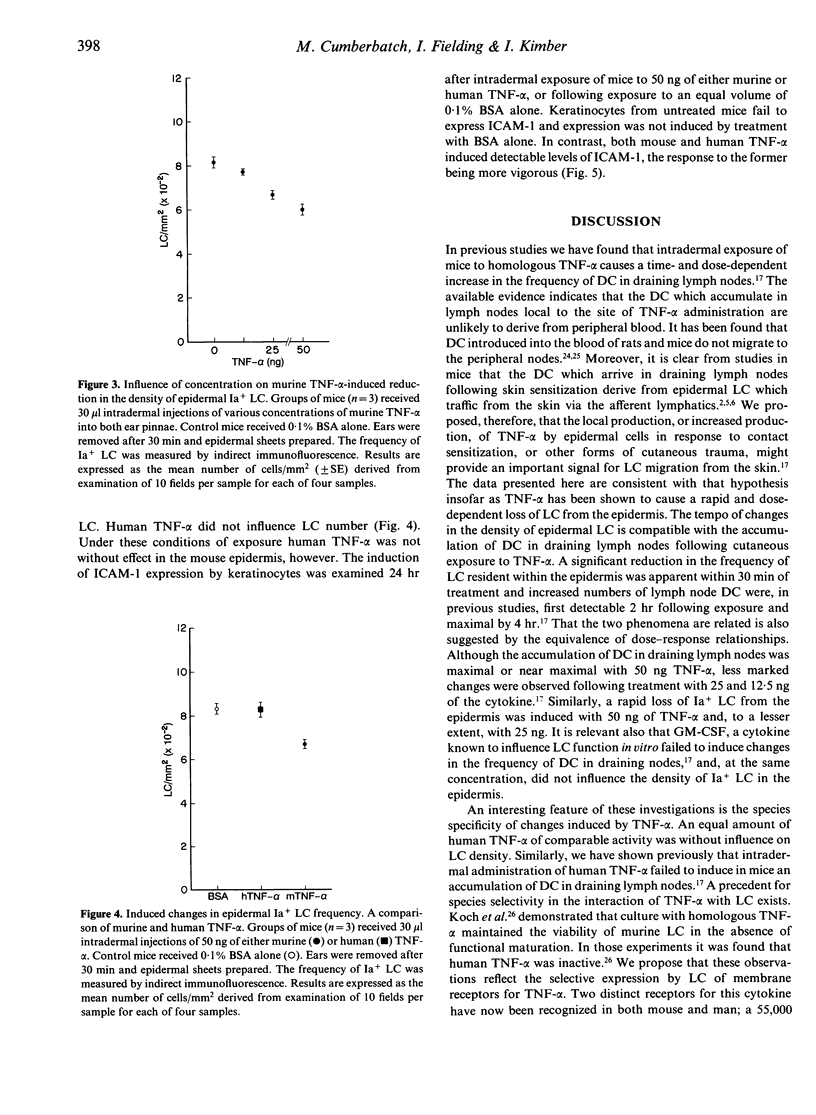
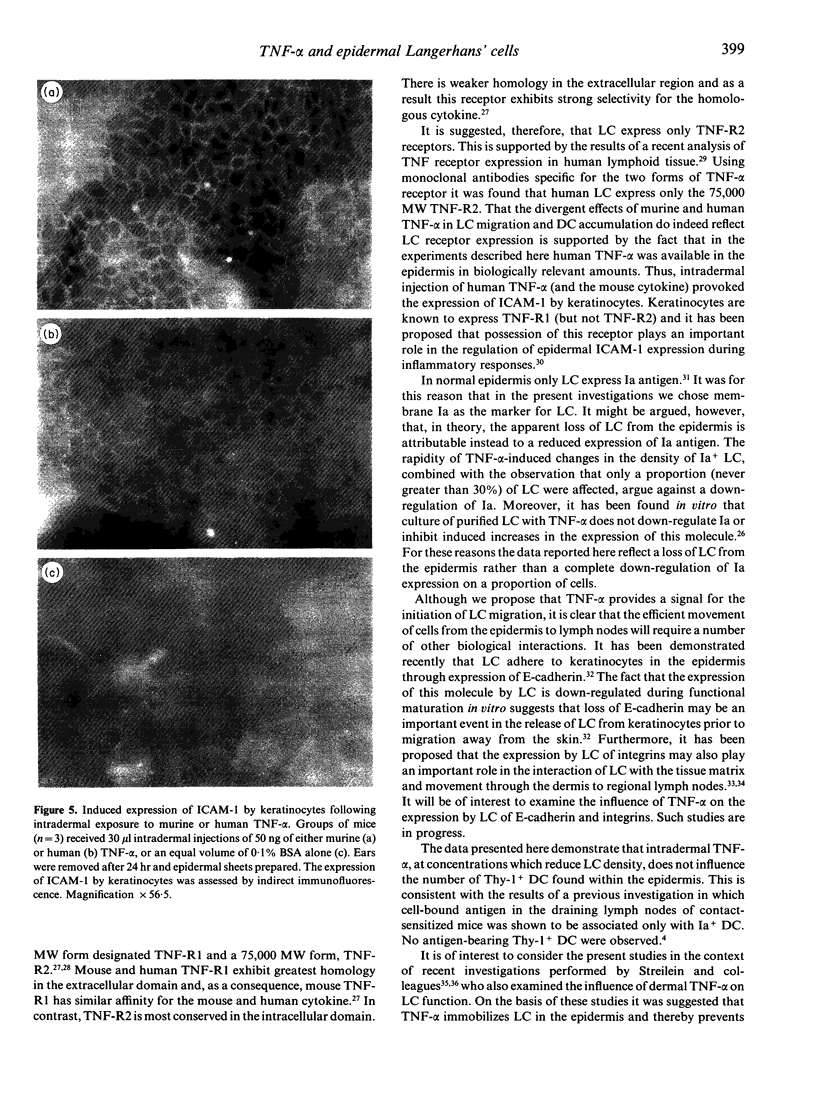
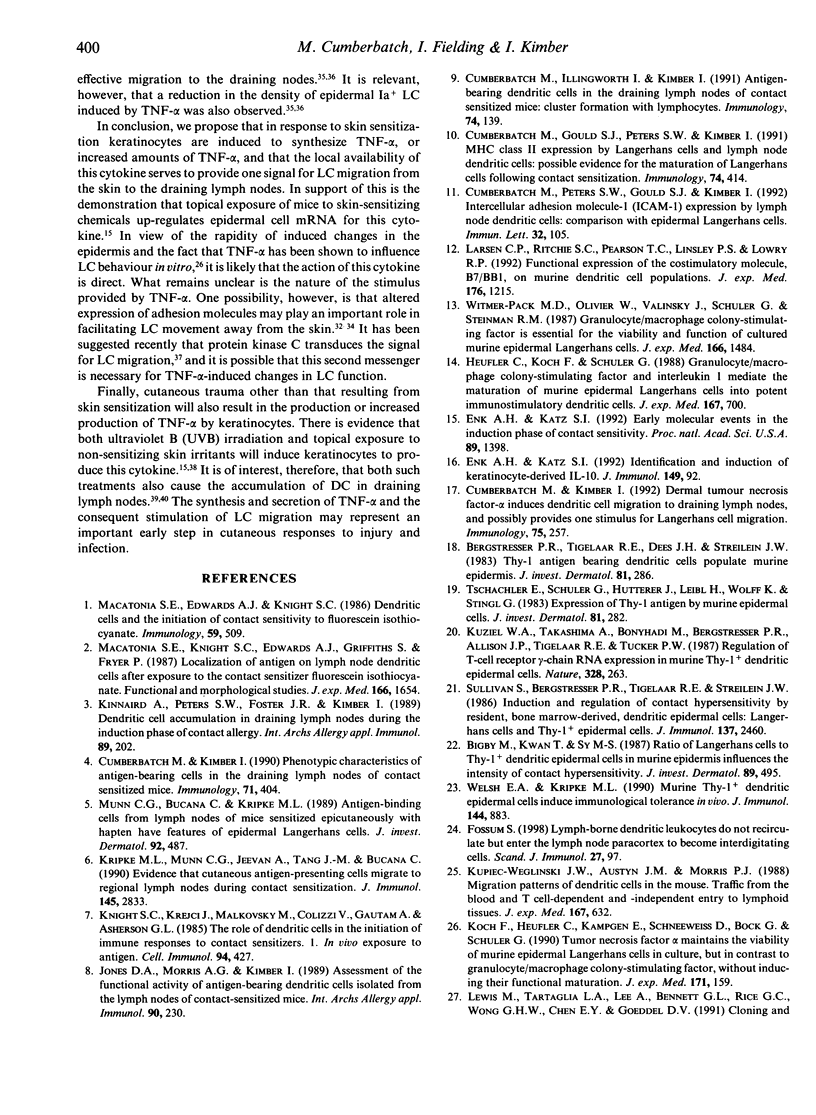
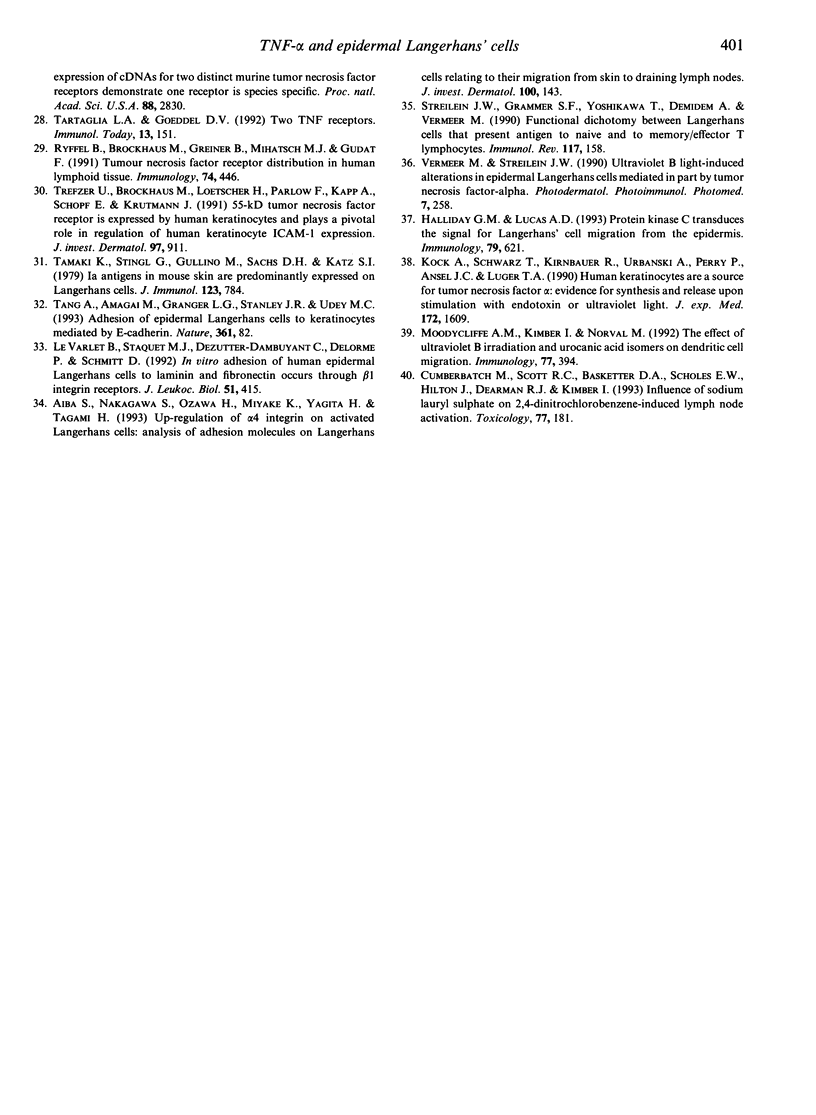
Images in this article
Selected References
These references are in PubMed. This may not be the complete list of references from this article.
- Aiba S., Nakagawa S., Ozawa H., Miyake K., Yagita H., Tagami H. Up-regulation of alpha 4 integrin on activated Langerhans cells: analysis of adhesion molecules on Langerhans cells relating to their migration from skin to draining lymph nodes. J Invest Dermatol. 1993 Feb;100(2):143–147. doi: 10.1111/1523-1747.ep12462783. [DOI] [PubMed] [Google Scholar]
- Bergstresser P. R., Tigelaar R. E., Dees J. H., Streilein J. W. Thy-1 antigen-bearing dendritic cells populate murine epidermis. J Invest Dermatol. 1983 Sep;81(3):286–288. doi: 10.1111/1523-1747.ep12518332. [DOI] [PubMed] [Google Scholar]
- Bigby M., Kwan T., Sy M. S. Ratio of Langerhans cells to Thy-1+ dendritic epidermal cells in murine epidermis influences the intensity of contact hypersensitivity. J Invest Dermatol. 1987 Nov;89(5):495–499. doi: 10.1111/1523-1747.ep12460983. [DOI] [PubMed] [Google Scholar]
- Cumberbatch M., Gould S. J., Peters S. W., Kimber I. MHC class II expression by Langerhans' cells and lymph node dendritic cells: possible evidence for maturation of Langerhans' cells following contact sensitization. Immunology. 1991 Nov;74(3):414–419. [PMC free article] [PubMed] [Google Scholar]
- Cumberbatch M., Illingworth I., Kimber I. Antigen-bearing dendritic cells in the draining lymph nodes of contact sensitized mice: cluster formation with lymphocytes. Immunology. 1991 Sep;74(1):139–145. [PMC free article] [PubMed] [Google Scholar]
- Cumberbatch M., Kimber I. Dermal tumour necrosis factor-alpha induces dendritic cell migration to draining lymph nodes, and possibly provides one stimulus for Langerhans' cell migration. Immunology. 1992 Feb;75(2):257–263. [PMC free article] [PubMed] [Google Scholar]
- Cumberbatch M., Kimber I. Phenotypic characteristics of antigen-bearing cells in the draining lymph nodes of contact sensitized mice. Immunology. 1990 Nov;71(3):404–410. [PMC free article] [PubMed] [Google Scholar]
- Cumberbatch M., Peters S. W., Gould S. J., Kimber I. Intercellular adhesion molecule-1 (ICAM-1) expression by lymph node dendritic cells: comparison with epidermal Langerhans cells. Immunol Lett. 1992 Apr;32(2):105–110. doi: 10.1016/0165-2478(92)90101-s. [DOI] [PubMed] [Google Scholar]
- Cumberbatch M., Scott R. C., Basketter D. A., Scholes E. W., Hilton J., Dearman R. J., Kimber I. Influence of sodium lauryl sulphate on 2,4-dinitrochlorobenzene-induced lymph node activation. Toxicology. 1993 Jan 29;77(1-2):181–191. doi: 10.1016/0300-483x(93)90148-l. [DOI] [PubMed] [Google Scholar]
- Enk A. H., Katz S. I. Early molecular events in the induction phase of contact sensitivity. Proc Natl Acad Sci U S A. 1992 Feb 15;89(4):1398–1402. doi: 10.1073/pnas.89.4.1398. [DOI] [PMC free article] [PubMed] [Google Scholar]
- Enk A. H., Katz S. I. Identification and induction of keratinocyte-derived IL-10. J Immunol. 1992 Jul 1;149(1):92–95. [PubMed] [Google Scholar]
- Fossum S. Lymph-borne dendritic leucocytes do not recirculate, but enter the lymph node paracortex to become interdigitating cells. Scand J Immunol. 1988 Jan;27(1):97–105. doi: 10.1111/j.1365-3083.1988.tb02326.x. [DOI] [PubMed] [Google Scholar]
- Halliday G. M., Lucas A. D. Protein kinase C transduces the signal for Langerhans' cell migration from the epidermis. Immunology. 1993 Aug;79(4):621–626. [PMC free article] [PubMed] [Google Scholar]
- Heufler C., Koch F., Schuler G. Granulocyte/macrophage colony-stimulating factor and interleukin 1 mediate the maturation of murine epidermal Langerhans cells into potent immunostimulatory dendritic cells. J Exp Med. 1988 Feb 1;167(2):700–705. doi: 10.1084/jem.167.2.700. [DOI] [PMC free article] [PubMed] [Google Scholar]
- Jones D. A., Morris A. G., Kimber I. Assessment of the functional activity of antigen-bearing dendritic cells isolated from the lymph nodes of contact-sensitized mice. Int Arch Allergy Appl Immunol. 1989;90(3):230–236. doi: 10.1159/000235030. [DOI] [PubMed] [Google Scholar]
- Kinnaird A., Peters S. W., Foster J. R., Kimber I. Dendritic cell accumulation in draining lymph nodes during the induction phase of contact allergy in mice. Int Arch Allergy Appl Immunol. 1989;89(2-3):202–210. doi: 10.1159/000234947. [DOI] [PubMed] [Google Scholar]
- Knight S. C., Krejci J., Malkovsky M., Colizzi V., Gautam A., Asherson G. L. The role of dendritic cells in the initiation of immune responses to contact sensitizers. I. In vivo exposure to antigen. Cell Immunol. 1985 Sep;94(2):427–434. doi: 10.1016/0008-8749(85)90266-7. [DOI] [PubMed] [Google Scholar]
- Koch F., Heufler C., Kämpgen E., Schneeweiss D., Böck G., Schuler G. Tumor necrosis factor alpha maintains the viability of murine epidermal Langerhans cells in culture, but in contrast to granulocyte/macrophage colony-stimulating factor, without inducing their functional maturation. J Exp Med. 1990 Jan 1;171(1):159–171. doi: 10.1084/jem.171.1.159. [DOI] [PMC free article] [PubMed] [Google Scholar]
- Kripke M. L., Munn C. G., Jeevan A., Tang J. M., Bucana C. Evidence that cutaneous antigen-presenting cells migrate to regional lymph nodes during contact sensitization. J Immunol. 1990 Nov 1;145(9):2833–2838. [PubMed] [Google Scholar]
- Kupiec-Weglinski J. W., Austyn J. M., Morris P. J. Migration patterns of dendritic cells in the mouse. Traffic from the blood, and T cell-dependent and -independent entry to lymphoid tissues. J Exp Med. 1988 Feb 1;167(2):632–645. doi: 10.1084/jem.167.2.632. [DOI] [PMC free article] [PubMed] [Google Scholar]
- Kuziel W. A., Takashima A., Bonyhadi M., Bergstresser P. R., Allison J. P., Tigelaar R. E., Tucker P. W. Regulation of T-cell receptor gamma-chain RNA expression in murine Thy-1+ dendritic epidermal cells. Nature. 1987 Jul 16;328(6127):263–266. doi: 10.1038/328263a0. [DOI] [PubMed] [Google Scholar]
- Köck A., Schwarz T., Kirnbauer R., Urbanski A., Perry P., Ansel J. C., Luger T. A. Human keratinocytes are a source for tumor necrosis factor alpha: evidence for synthesis and release upon stimulation with endotoxin or ultraviolet light. J Exp Med. 1990 Dec 1;172(6):1609–1614. doi: 10.1084/jem.172.6.1609. [DOI] [PMC free article] [PubMed] [Google Scholar]
- Larsen C. P., Ritchie S. C., Pearson T. C., Linsley P. S., Lowry R. P. Functional expression of the costimulatory molecule, B7/BB1, on murine dendritic cell populations. J Exp Med. 1992 Oct 1;176(4):1215–1220. doi: 10.1084/jem.176.4.1215. [DOI] [PMC free article] [PubMed] [Google Scholar]
- Le Varlet B., Staquet M. J., Dezutter-Dambuyant C., Delorme P., Schmitt D. In vitro adhesion of human epidermal Langerhans cells to laminin and fibronectin occurs through beta 1 integrin receptors. J Leukoc Biol. 1992 Apr;51(4):415–420. doi: 10.1002/jlb.51.4.415. [DOI] [PubMed] [Google Scholar]
- Lewis M., Tartaglia L. A., Lee A., Bennett G. L., Rice G. C., Wong G. H., Chen E. Y., Goeddel D. V. Cloning and expression of cDNAs for two distinct murine tumor necrosis factor receptors demonstrate one receptor is species specific. Proc Natl Acad Sci U S A. 1991 Apr 1;88(7):2830–2834. doi: 10.1073/pnas.88.7.2830. [DOI] [PMC free article] [PubMed] [Google Scholar]
- Macatonia S. E., Edwards A. J., Knight S. C. Dendritic cells and the initiation of contact sensitivity to fluorescein isothiocyanate. Immunology. 1986 Dec;59(4):509–514. [PMC free article] [PubMed] [Google Scholar]
- Macatonia S. E., Knight S. C., Edwards A. J., Griffiths S., Fryer P. Localization of antigen on lymph node dendritic cells after exposure to the contact sensitizer fluorescein isothiocyanate. Functional and morphological studies. J Exp Med. 1987 Dec 1;166(6):1654–1667. doi: 10.1084/jem.166.6.1654. [DOI] [PMC free article] [PubMed] [Google Scholar]
- Moodycliffe A. M., Kimber I., Norval M. The effect of ultraviolet B irradiation and urocanic acid isomers on dendritic cell migration. Immunology. 1992 Nov;77(3):394–399. [PMC free article] [PubMed] [Google Scholar]
- Ryffel B., Brockhaus M., Greiner B., Mihatsch M. J., Gudat F. Tumour necrosis factor receptor distribution in human lymphoid tissue. Immunology. 1991 Nov;74(3):446–452. [PMC free article] [PubMed] [Google Scholar]
- Sullivan S., Bergstresser P. R., Tigelaar R. E., Streilein J. W. Induction and regulation of contact hypersensitivity by resident, bone marrow-derived, dendritic epidermal cells: Langerhans cells and Thy-1+ epidermal cells. J Immunol. 1986 Oct 15;137(8):2460–2467. [PubMed] [Google Scholar]
- Tamaki K., Stingl G., Gullino M., Sachs D. H., Katz S. I. Ia antigens in mouse skin are predominantly expressed on Langerhans cells. J Immunol. 1979 Aug;123(2):784–787. [PubMed] [Google Scholar]
- Tang A., Amagai M., Granger L. G., Stanley J. R., Udey M. C. Adhesion of epidermal Langerhans cells to keratinocytes mediated by E-cadherin. Nature. 1993 Jan 7;361(6407):82–85. doi: 10.1038/361082a0. [DOI] [PubMed] [Google Scholar]
- Tschachler E., Schuler G., Hutterer J., Leibl H., Wolff K., Stingl G. Expression of Thy-1 antigen by murine epidermal cells. J Invest Dermatol. 1983 Sep;81(3):282–285. doi: 10.1111/1523-1747.ep12518326. [DOI] [PubMed] [Google Scholar]
- Vermeer M., Streilein J. W. Ultraviolet B light-induced alterations in epidermal Langerhans cells are mediated in part by tumor necrosis factor-alpha. Photodermatol Photoimmunol Photomed. 1990 Dec;7(6):258–265. [PubMed] [Google Scholar]
- Welsh E. A., Kripke M. L. Murine Thy-1+ dendritic epidermal cells induce immunologic tolerance in vivo. J Immunol. 1990 Feb 1;144(3):883–891. [PubMed] [Google Scholar]
- Witmer-Pack M. D., Olivier W., Valinsky J., Schuler G., Steinman R. M. Granulocyte/macrophage colony-stimulating factor is essential for the viability and function of cultured murine epidermal Langerhans cells. J Exp Med. 1987 Nov 1;166(5):1484–1498. doi: 10.1084/jem.166.5.1484. [DOI] [PMC free article] [PubMed] [Google Scholar]



